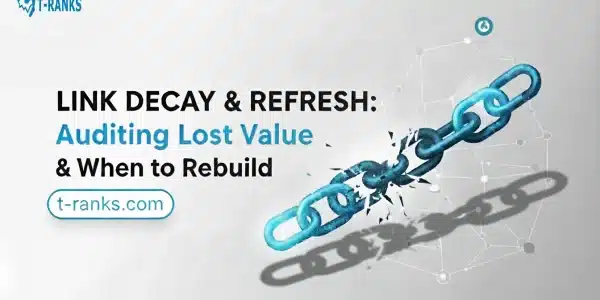Ever heard of link decay or link rot? It’s when backlinks that once boosted your SEO start to break, fade, or lose relevance over time. This hidden decay quietly drains your site’s authority and rankings.
With the T-RANKS Link Decay & Refresh Framework, you can spot weak links early, recover lost equity, and rebuild stronger connections that last. This guide explains how to identify link decay, measure lost value, refresh outdated assets, and prevent future link loss through regular audits and smart link hygiene.
Stay ahead of decay. Learn how to protect, refresh, and preserve your link equity for long-term SEO stability .
What Is Link Decay
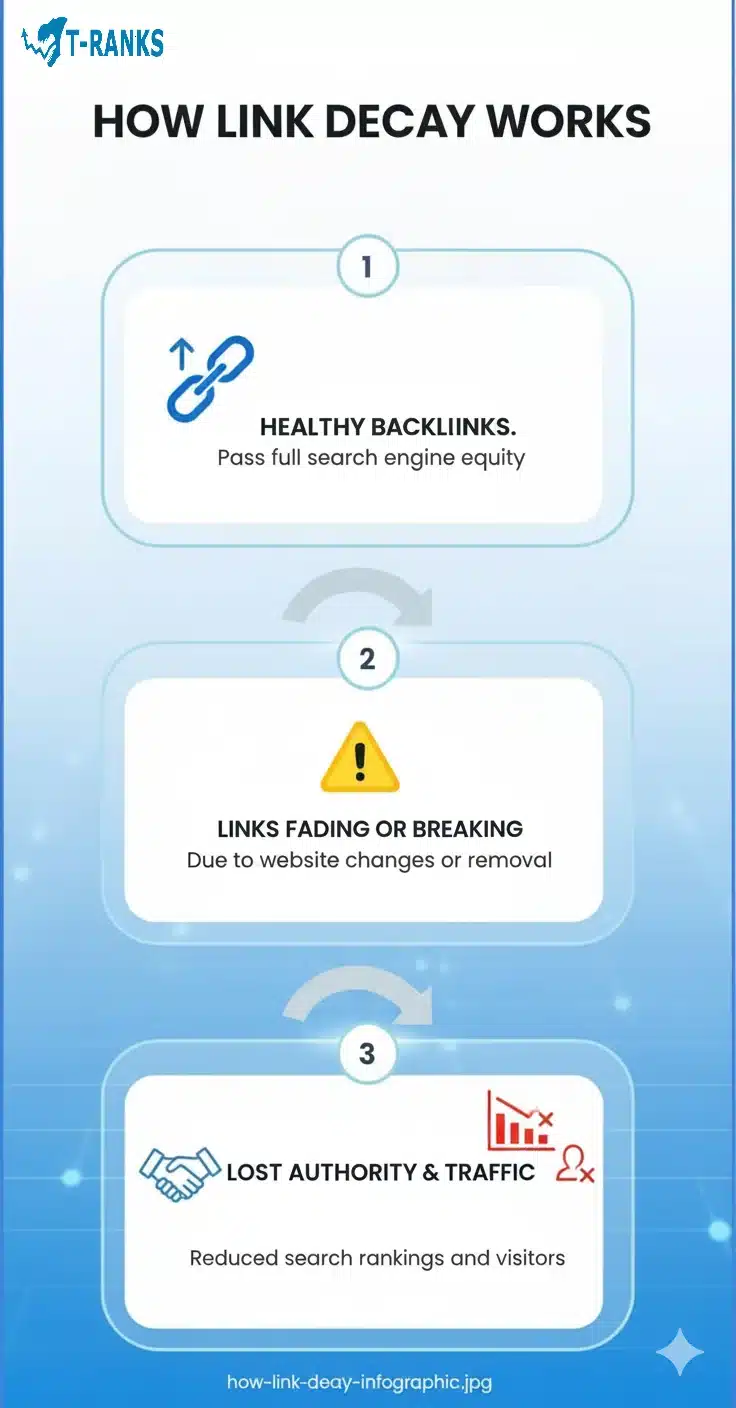
Link decay also known as link rot—means your backlinks gradually lose strength, trust, and SEO value over time. It’s not a rare problem. A large-scale Ahrefs study found that 66.5% of all links pointing to over 2 million websites have already rotted since 2013.
When pages are deleted, moved, or updated without proper redirects, link equity breaks. This weakens your site’s authority flow, topical relevance, and visibility in both Google Search and AI-driven discovery systems.
Think of it like your backlinks fading in strength over time. Even if the link still exists, it may no longer help your rankings because of technical issues, outdated content, or context drift. Regular link audits keep your backlink profile healthy, preserve authority, and maintain consistent SEO performance.
Example:
A marketing blog once linked to your “SEO Audit Template.” Months later, they updated the article, replaced your anchor text, and added dozens of new outbound links. Your backlink still exists, but it now passes far less value and topical relevance than before.
How Link Decay Happens: Rot, Dilution & Drift
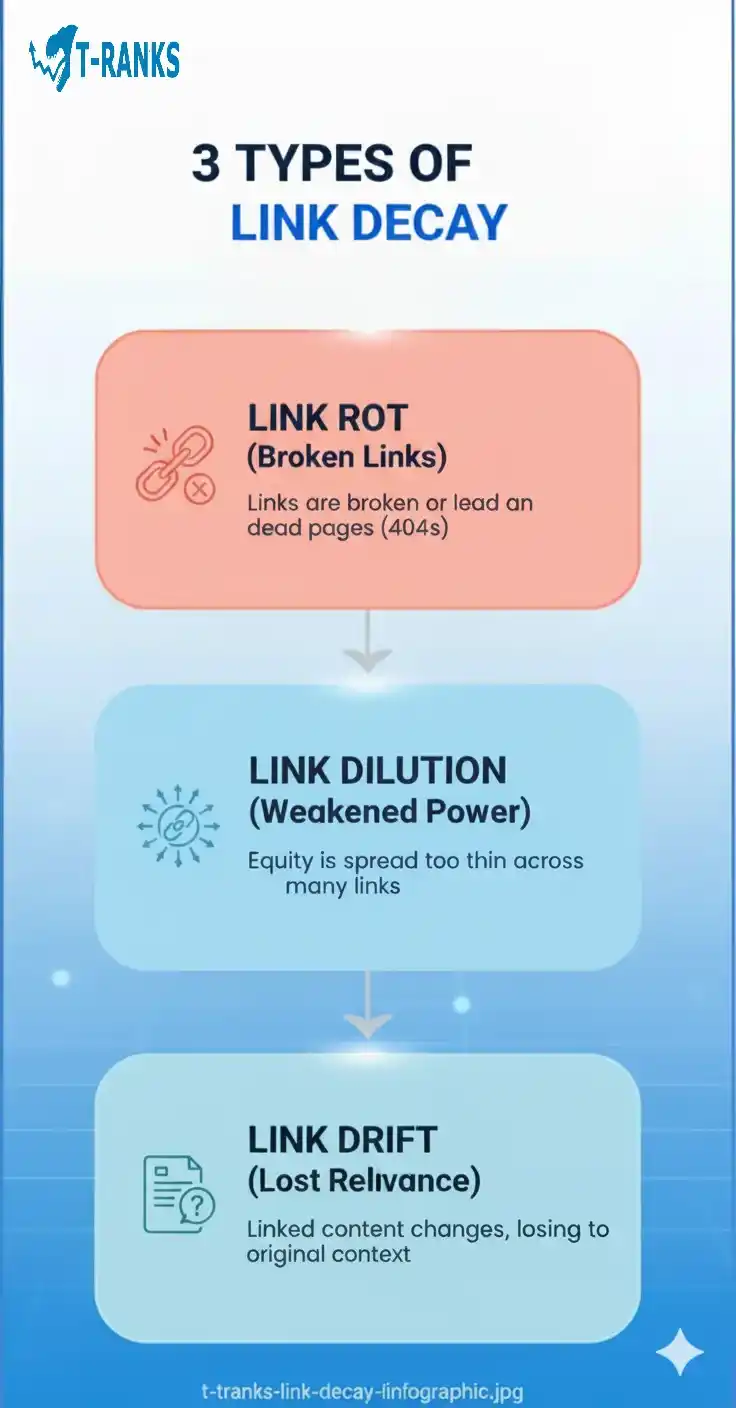
Now that you know what link decay is, let’s explore how it actually happens. Not all backlinks weaken in the same way. In most cases, link decay appears in three main forms Link Rot, Link Dilution, and Link Drift. Each type affects your SEO differently but leads to one common result: loss of authority, trust, and visibility.
Link Rot (Broken Links) — The Technical Side of Link Decay
Link rot is the most visible and damaging form of link decay. It occurs when a backlink points to a deleted or missing page, often showing a 404 error. Once this connection breaks, the linked authority is completely lost, and no link equity passes through.
Example: A tech blog once linked to your SEO guide, but later deleted that page. Instantly, your valuable backlink turned into a dead link cutting off all the authority it once passed.
Link Dilution (Weakened Power) — The Structural Side of Link Decay
Link dilution happens when your backlink remains active but competes with too many other outbound links on the same page. This splits the “link juice,” reducing the amount of SEO value flowing to your website. Long redirect chains can worsen this effect by slowing or disrupting equity transfer.
Example: Your backlink appears on a “Top 100 SEO Tools” roundup that lists dozens of links. Even though the link works, your share of equity is tiny — making its impact on rankings minimal.
Link Drift (Lost Relevance) — The Contextual Side of Link Decay
Link drift is a quieter, more subtle type of decay. It happens when the page containing your backlink changes focus over time. The link stays live, but the surrounding content no longer matches your topic ,weakening its contextual relevance in Google’s eyes.
Example: A marketing site once linked to your “SEO Audit Guide.” Months later, they updated the article to cover “Social Media Tips.” The link still exists but now feels out of place, losing its topical strength and ranking influence.
Causes of Link Decay (Technical, Editorial, and Network)
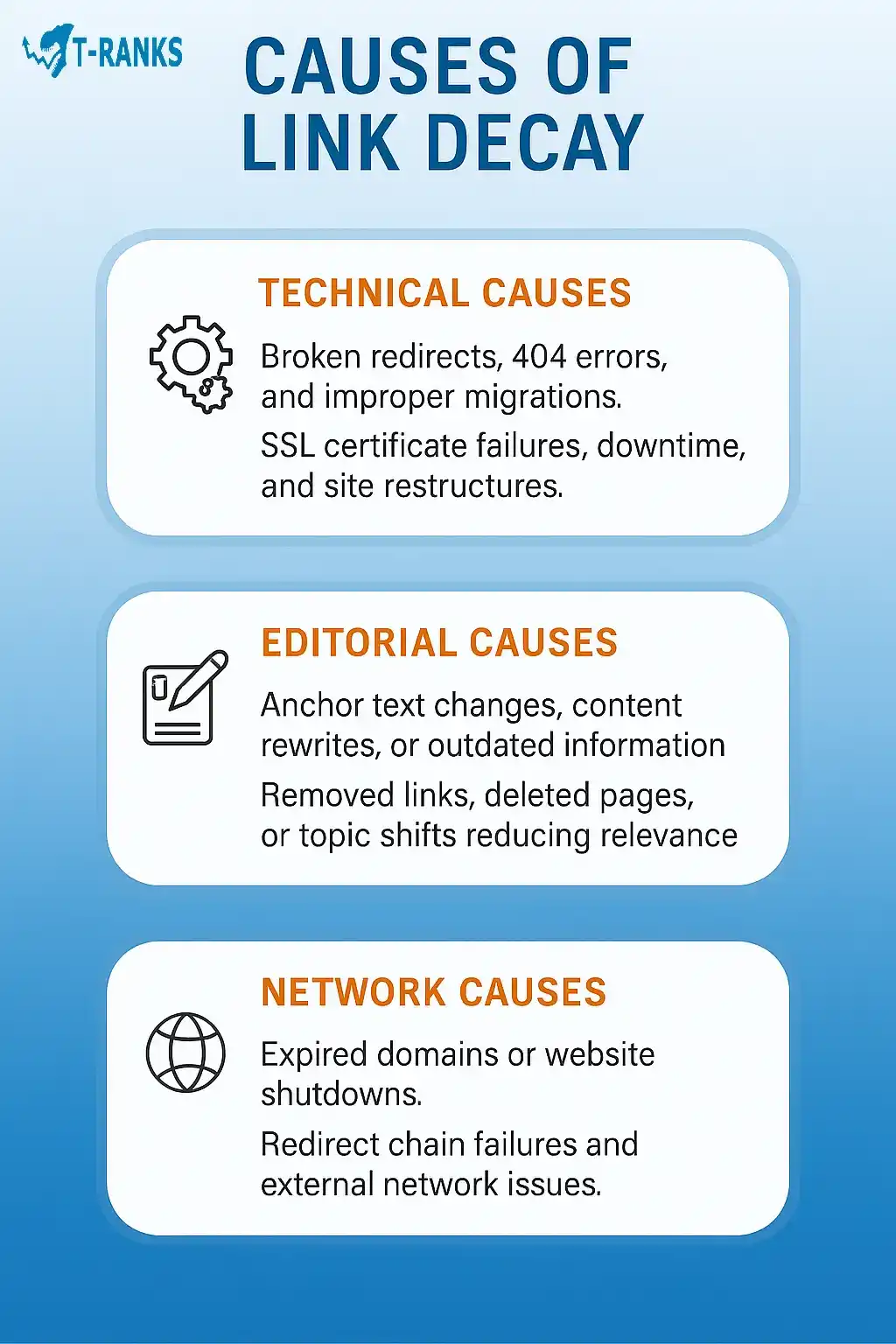
Link decay happens when backlinks gradually lose their strength because of technical errors, editorial changes, or external network issues. These problems disrupt link connections, reduce link equity, and weaken your website’s authority, crawlability, and SEO rankings.
In SEO, link decay isn’t random. It’s a predictable process you can prevent with consistent monitoring and maintenance. By understanding its three main causes — technical, editorial, and network — you can identify risks early, fix decayed links, and maintain a trustworthy backlink profile across Google and AI-powered search systems.
1. Technical Causes of Link Decay
Technical decay occurs when your website’s structure or backend breaks the flow of link equity. These issues are usually easy to detect through regular site audits but can silently erode your rankings if ignored.
Main Technical Factors
- Website migrations without redirects: Moving to a new domain or CMS without setting up 301 redirects breaks all existing backlinks.
Example: A brand moves from example.com to example.io without redirects, causing every old backlink to return a 404 error.
- Changed URL structures: Updating URLs or slugs without redirecting the old ones results in immediate link loss.
Example: A blog changes /blog/post-name to /articles/post-name, invalidating every backlink that used the old format.
- Deleted or moved content: Removing pages, files, or images without replacements creates broken links and 404 errors.
Example: A resource page titled “SEO Templates” is deleted, and all backlinks pointing to it lose value instantly.
- Server or hosting failures: Downtime, DNS issues, or SSL errors make linked pages temporarily unreachable.
Example: A two-day server outage stops Google from crawling your linked pages, reducing trust and visibility.
- Noindex or canonical mistakes: Wrong meta tags or canonical links can block link equity from flowing properly.
Example: A “noindex” tag mistakenly added to a product page prevents valuable backlinks from passing authority.
Pro Tip: Always perform a redirect and crawl audit after major site updates or migrations. Even one broken redirect chain can quietly drain your SEO authority.
2. Editorial Causes of Link Decay
Editorial decay results from human changes rewriting content, removing links, or altering anchors that unintentionally reduce backlink effectiveness. It’s a content-level issue that weakens the connection between linked pages.
Main Editorial Factors
- Content rewrites or repurposing: When an article changes its focus, the old backlinks may no longer fit the new topic.
Example: A “Best SEO Tools” post gets updated to “Best Social Media Tools,” and your backlink disappears.
- Anchor text changes: Modifying or deleting anchor text weakens the topical connection between pages.
Example: A blog changes “learn SEO audits” to “explore audits,” lowering contextual relevance.
- Outbound link pruning: Editors often remove older links to simplify or shorten articles, cutting off valuable backlinks.\
Example: A publisher removes your link while updating outdated resources.
- Excessive outbound links: Pages overloaded with external links split their authority too thinly, making each link weaker.
Example: A “Top 200 Tools” directory passes little to no SEO value to any single link.
- Linking to unstable sources: Linking to temporary or volatile platforms like social media posts can lead to quick decay.
Example: A blog references a tweet that later gets deleted, breaking the connection.
Pro Tip: During every content update, review and retain high-value links. Keeping quality links intact preserves topical relevance and SEO strength.
3. Network Causes of Link Decay
Network decay occurs outside your direct control. It’s caused by external events such as expired domains, website closures, or redirect failures that can erase healthy backlinks overnight.
Main Network Factors
- Expired domains: When a linking site doesn’t renew its domain, all backlinks from it vanish.
Example: A startup that once linked to your case study fails to renew its domain, and your backlink disappears.
- Website shutdowns: When a company or publisher closes, all its pages and backlinks are permanently removed.
Example: A guest post you wrote for a news portal is lost when the site shuts down.
- Redirect chain failures: Multi-step redirects often collapse when any link in the chain breaks, cutting off link flow.
Example: A link path from Page A to D fails completely if Page B in the sequence expires.
Pro Tip: Use tools like Ahrefs Alerts, Google Search Console Coverage, and UptimeRobot to monitor backlink activity. Detecting broken connections early allows faster outreach and recovery before SEO loss spreads.
How to Measure Link Decay (A Step-by-Step Practical Guide)
Link decay silently eats away at your site’s authority over time — but only if you ignore it. By learning to measure it properly, you can stop equity loss, reclaim valuable backlinks, and strengthen your ranking power.
At T-RANKS, this seven-step process is used in real client campaigns to identify lost links, recover equity, and keep authority flowing through every cluster.
Step 1: Audit Lost Value (Link Equity and Relevance)
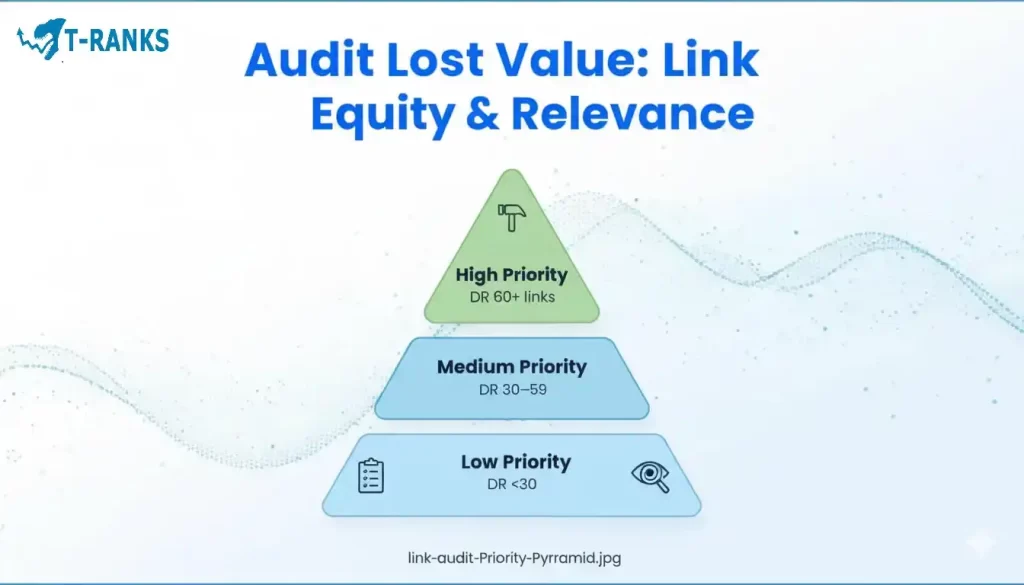
Before fixing anything, you need to see where your backlinks are leaking value. This audit reveals which links have lost strength, which still drive traffic, and which ones silently hold your rankings back.
How to do it
- Open Ahrefs and go to Backlinks → Lost Backlinks for the past 90 days.
- Export details like referring domains, DR/UR, anchor text, and target URLs.
- In Google Search Console, check Coverage for 404s or redirect errors.
- Prioritize links by authority, traffic impact, and topical relevance.
- Record everything in a simple “Link Risk Matrix.”
| Priority | Criteria | Action |
| High | DR 60+ and strong topical match | Fix or reclaim immediately |
| Medium | DR 30–59, moderate traffic | Plan batch outreach |
| Low | DR < 30 or weak context | Monitor or ignore |
Example: If you lost ten links from DR 70+ blogs to your SEO Audit Template, reclaiming just three could restore up to 30% of lost traffic.
Step 2: Diagnose and Classify the Loss Type
Next, find out why each backlink decayed. Every loss has a cause — technical errors, content changes, or relevance drift. By diagnosing the reason, you know exactly which recovery method to apply.
How to do it
- Use Ahrefs to check each lost link’s status code.
- Crawl those URLs with Screaming Frog to confirm if they’re live or blocked by “noindex.”
- Group them into categories:
| Type | Description | Fix |
| Rot | Page deleted or 404 | Add redirect or restore page |
| Redirected | Long 301/302 chains | Simplify into one redirect |
| Removed Anchor | Link deleted in update | Contact the editor |
| Noindex | Source blocked from Google | Remove “noindex” tag |
| Drift | Topic changed or lost context | Refresh or realign content |
Example: If Ahrefs flags 15 lost links, you might see five 404s, three removed anchors, and seven that drifted each needing a tailored fix.
Step 3: Reclaim, Rebuild, or Replace
Now that you know the cause, it’s time to fix it. Some links can be restored, others rebuilt with new content, and a few replaced with better ones.
How to do it
- Reclaim: If the linking page still exists, reach out and ask to reinstate your link.
- Rebuild: If the page is gone, create an updated version of the content and re-pitch it.
- Replace: If the topic has shifted, offer a new resource that fits their updated focus.
Example email:
“Hi [Name], I noticed the link to our SEO Guide on [URL] is no longer working. We’ve updated the resource with new data — here’s the refreshed version if you’d like to update it. Thanks!”
Even a 20% success rate on reclamation can recover hundreds of sessions and valuable domain authority.
Step 4: Refresh Linked Assets
Once you’ve reclaimed links, strengthen the pages they point to. Refreshing linked assets keeps them relevant, authoritative, and attractive to new backlinks.
How to do it
- Update old sections with 2025 data, new visuals, or stats.
- Add FAQ or Article schema to improve structured visibility.
- Strengthen E-E-A-T with expert insights and author bios.
- Make content easier to read short paragraphs, clear headings, current references.
Example: Updating “Local SEO Checklist 2023” to “Local SEO Trends 2025” can bring back old backlinks and attract new ones naturally.
Step 5: Patch Internal Links (Preserve Equity Flow)
External links bring authority in; internal links redirect chains spread it across your site. If internal links are broken, redirected, or missing, valuable link juice gets trapped.
How to do it
- Fix internal 404s and redirects using Screaming Frog or GSC.
- Add fresh contextual links from your top pages to refreshed ones.
- Build a hub-and-spoke structure to connect related topics.
- Keep all important pages within three clicks of your homepage.
Example: After reclaiming links to your “SEO Basics” guide, link it to “Keyword Research” and “Content Optimization.” This helps the entire cluster rank higher.
Step 6: Monitor Decay Signals Regularly
Link decay never stops completely. Set up automated alerts to detect issues before they impact traffic.
How to do it
- Set Ahrefs Lost Backlink Alerts weekly.
- Watch GSC Coverage for 404 or noindex spikes.
- Keep your Growth-to-Decay ratio above 1.2:1.
- Use Zapier or Slack alerts for sudden backlink losses.
- Track brand citations in Gemini and Perplexity to maintain AI visibility.
Example: You notice a 10% backlink drop in a weekly report, fix a redirect error the same day, and prevent a ranking decline.
Step 7: Report Equity Gains and ROI

Finally, translate your link recovery work into business results. This shows how each fix restored traffic, improved rankings, and delivered measurable ROI.
How to do it
- Compare traffic and rankings before and after recovery.
- Measure total links restored, authority regained, and cluster performance.
- Use this simple ROI formula: ROI = ((Traffic Value Gained – Cost) ÷ Cost) × 100
- Create a visual report in Looker Studio or GA4 showing before-and-after metrics.
Example: After a T-RANKS audit, a SaaS client reclaimed 30 high-DR links, boosted sessions by 25%, and achieved a 310% ROI in two months.
In Summary
Measuring link decay turns hidden SEO losses into measurable wins. By following these steps audit, diagnose, reclaim, refresh, patch, monitor, and report . You can turn lost backlinks into long-term authority that Google, Gemini, and Perplexity recognize.
When managed proactively, link decay isn’t a setback. It’s your opportunity to rebuild stronger, preserve your rankings, and maintain sustainable SEO growth.
CTA: Get your free T-RANKS Link Decay Dashboard and start tracking lost value today.
Preventing Future Link Decay (Simple Everyday SEO Hygiene)
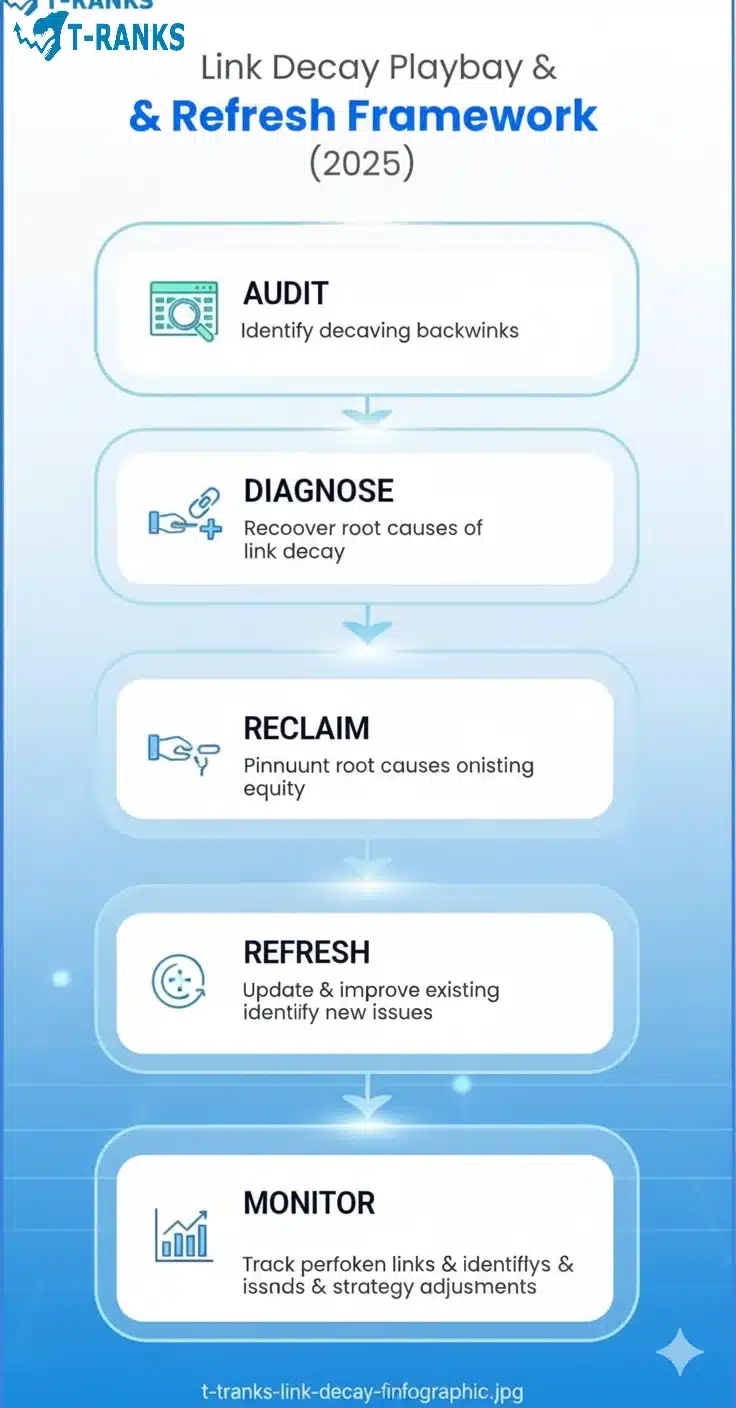
Preventing link decay means keeping your backlinks healthy so they don’t lose power over time. It’s about simple habits: keep your website stable, update your content, build clean links, and check your site regularly. When you do this, your rankings stay steady, and your backlinks keep working for you.
1. Keep Your Website Technically Healthy
A strong website keeps your backlinks safe. If your pages, redirects, and URLs stay the same, your backlinks won’t break or lose value.
How to do it
- Use simple, short URLs that don’t change often.
- Before moving or deleting pages, set up 301 redirects.
- Fix broken pages and redirect errors quickly.
- Use Screaming Frog to find 404 errors or redirect chains.
- Check that your SSL certificate and hosting stay active so links always load.
Tip: Every time you redesign or update your site, run a quick redirect check. It saves your backlink authority.
2. Keep Your Content Fresh and Useful
Good content keeps backlinks relevant. When your pages stay updated, the sites linking to you stay valid in Google’s eyes.
How to do it
- Update important pages every few months with new examples or data.
- Use Ahrefs → Best by Links to find pages that attract the most backlinks.
- Instead of deleting old articles, refresh or combine them into stronger evergreen posts.
- Add internal links from your latest blogs to older, valuable pages.
Tip: When you update a post, don’t change its URL. Update the content inside so your backlinks remain intact.
3. Build and Maintain Clean Links
Not all links are equal. The quality and stability of your backlinks matter more than the number of them.
How to do it
- Get backlinks from trusted websites that update regularly.
- Use natural, descriptive anchor text (avoid “click here” or “read more”).
- Avoid linking to unreliable sites that might disappear.
- Check your outbound links in Google Search Console to make sure they still work.
- Keep external links limited and relevant to your topic.
Tip: Before accepting or placing any backlink, look at how old the website is and whether it posts consistently. Older, stable domains last longer.
4. Monitor and Fix Problems Early
Even healthy websites lose some links over time. By checking regularly, you can catch problems early and fix them before rankings drop.
How to do it
- Turn on Ahrefs Lost Backlink Alerts to get weekly updates.
- In GSC, check the Coverage report for missing or redirected pages.
- Use Screaming Frog to crawl your site every three months.
- Keep a small tracking sheet where you record fixed links and new issues.
Tip: Set a reminder once a month to check your site. Small, regular fixes prevent big losses later.
5. Focus on Stable Backlinks (LSF Score)
Some backlinks are naturally more stable than others. The Link Stability Factor (LSF) helps you see which ones are worth keeping long-term.
How to do it
- Give each backlink a simple score from 1 to 5.
- Older, high-authority sites get a higher score.
- Focus your outreach and link recovery on sites with higher LSF values.
- Replace unstable links (from new or spammy sites) with stronger ones.
Tip: A link from a 10-year-old website is usually more reliable than a new blog that might disappear next year.
6. Follow a Simple 3-Month Routine
Make link hygiene a habit. Every three months, do a quick check to keep everything clean and working.
What to do
- Fix redirects and broken links.
- Refresh your top-performing content.
- Check lost backlinks in Ahrefs or GSC.
- Add new internal links to updated pages.
- Re-evaluate the stability (LSF) of your backlink sources.
Tip: Set a quarterly reminder in your calendar called “Backlink Health Check.” It takes less than an hour but saves a lot of SEO power
7. Use Tools That Make It Easy
You don’t need dozens of tools—just a few reliable ones.
- Ahrefs – find lost backlinks and best-performing pages.
- Screaming Frog – detect broken or redirected pages.
- Google Search Console – monitor errors and crawl issues.
- Looker Studio – create a simple dashboard to track link health over time.
Tip: Connect all these tools into one simple workflow. This way, your backlink health runs on autopilot.
In Summary
Preventing link decay isn’t complicated—it’s about staying consistent. Keep your site stable, update your pages, build quality links, and check regularly. These small steps protect your authority and help your website grow stronger every month.
Conclusion
Link decay simply means your backlinks lose power over time when pages break, move, or become outdated. If left unchecked, this weakens your website’s authority and visibility. The T-RANKS Link Decay & Refresh Framework helps you find, fix, and prevent these issues before they impact your SEO.
Follow a clear process audit, reclaim, refresh, and rebuild to protect your site’s trust and keep it performing well on Google, Gemini, and Perplexity. Regular audits, updated content, and smart internal linking help your backlinks stay strong and relevant.
Check your links every three months. Use LSF scoring to see which backlinks are strong and which may fade. Track link changes using Ahrefs, Google Search Console, and Screaming Frog. Always remember: it’s easier to prevent link decay than to fix it later.
Keep your backlinks clean, refreshed, and reliable with T-RANKS’ proven strategy.
FAQs Of Link Decay & Refresh
What’s the difference between link rot and link decay?
Link rot means a backlink is completely broken or removed, usually showing a 404 error. Link decay is a partial loss of ranking power caused by redirect chains building and managing PBN links, anchor drift, or outdated content that weakens link equity over time.
How long does it take for links to decay naturally?
Most links start losing measurable SEO value within 12 to 18 months. This happens when content updates, migrations, or editorial changes reduce relevance or remove original linking context.
Do redirects preserve link equity?
Redirects preserve about 80–90% of link equity if they’re clean and relevant. Long redirect chains, mismatched topics, or multiple hops can reduce equity further and harm crawl efficiency.
Can internal links decay too?
Yes. Internal links can decay when URLs are moved, deleted, or blocked by JavaScript rendering. This reduces crawl depth, internal authority flow, and topical alignment across your site.
Should I disavow decayed links?
No. Decayed links aren’t harmful unless they’re spammy or manipulative. Only disavow toxic or irrelevant backlinks associated with penalties or manual actions from Google.
How often should link audits be run?
Run link audits every quarter for active link-building campaigns and every six months for stable or evergreen websites. Regular auditing helps catch early signs of decay and maintain equity flow.
Can AI Overviews or LLMs lose citations due to link decay?
Yes. AI-powered engines like Google AI Overviews, Gemini, and Perplexity rely on live URLs. If your backlinks decay or vanish, your brand’s citations and visibility in AI answers can decline.
Does anchor text still pass value during decay?
Only if the referring content remains topically aligned. When the context or paragraph meaning changes, the anchor loses its semantic connection, reducing its ranking influence.
What’s the fastest way to reclaim decayed links?
Identify lost backlinks using Ahrefs or Semrush, recreate updated content, and perform outreach within seven days. A quick “updated resource” email can restore authority before the link’s value fades.
Is link rebuilding risky?
Not if done ethically and contextually. Safe rebuilding involves recreating relevant content and genuine outreach. Avoid mass automation or paid networks that can trigger algorithmic penalties.
